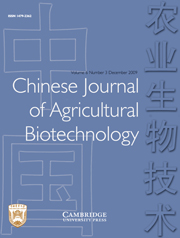Article contents
Effect of nanoparticles on the bacterial community of the cucumber phyllosphere
Published online by Cambridge University Press: 30 October 2009
Abstract
With the rapid development of nanotechnology, the security of nanomaterials has been an increasing cause for concern. In this study, the impact of titanium dioxide nanoparticles (nano-TiO2) on the phyllosphere bacterial community were analysed by both a culturable-dependent method and a polymerase chain reaction denaturing gradient gel electrophoresis (PCR-DGGE) method. The quantity of culturable phyllosphere bacteria was significantly reduced with an increased concentration of nano-TiO2. With increasing concentrations from 0.002 to 20 mg/ml of nano-TiO2, the quantity of culturable phyllosphere bacteria decreased from 1.8×106 to 3.1×105 cfu/g. The phyllosphere bacteria community was analysed by PCR-DGGE, and when the concentrations of nano-TiO2 were higher than 0.02 mg/ml, the DGGE bands were significantly lower than in the control. Sequencing results of the bands from the DGGE gel showed that there were at least seven genera in the phyllosphere bacteria. Only one uncultured bacterium was unaffected by the concentration of nano-TiO2.
- Type
- Research Papers
- Information
- Copyright
- Copyright © China Agricultural University 2009
References
- 3
- Cited by


